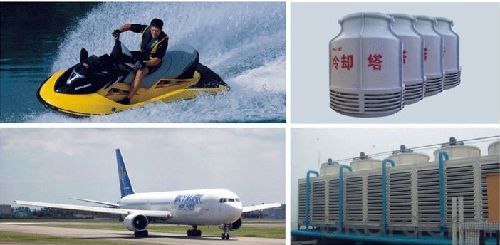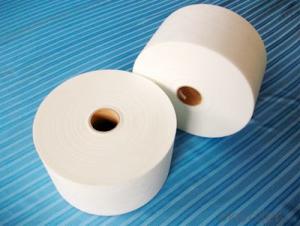Glass Fiber Felt For Pipe Coating
OKorder Service Pledge
OKorder Financial Service
You Might Also Like
Description:
Coated glass fiber mat is dedicated pipeline wet fiberglass mat coated for corrosion protection of buried steel is widely used in petroleum, natural gas pipeline anticorrosion coating.

Main features:
1, fibers uniformly dispersed
2, high strength, good flexibility
3, corrosion resistance, good flame retardant properties
4, anti-permeability good, strong resistance to environmental media capabilities

Technical specifications:
Product Code | Unit Weight(g/㎡) | Gum content(%) | Tendons from(mm) | Longitudinal tensile strength(N/5cm) | The transverse tensile strength(N/5cm) |
S-GD-50/T | 50 | 18 | 15,30 | ≥220 | ≥70 |
S-GD-60/T | 60 | 18 | 15,30 | ≥240 | ≥90 |
S-GD-90/T | 90 | 18 | 15,30 | ≥400 | ≥180 |
Packaging:
with cartons in pallets

FAQ:
1.What is the delivery time ?
15days after receiving the deposit
2.Are you a trading company or factory.
We are factory,and we have more than 10 years of experience.
- Q:How is fiberglass mat tissue used in the manufacturing of wind turbine blades?
- Fiberglass mat tissue is extensively used in the manufacturing of wind turbine blades due to its exceptional strength, durability, and lightweight properties. It serves as a critical reinforcement material that enhances the structural integrity and performance of the blades. During the manufacturing process, layers of fiberglass mat tissue are carefully placed and bonded together to form the composite structure of the wind turbine blade. The tissue layers are typically impregnated with a resin, such as epoxy or polyester, to create a strong and rigid matrix. The use of fiberglass mat tissue allows for the creation of complex blade shapes with high dimensional accuracy. It provides excellent resistance against various environmental factors, such as UV radiation, moisture, and temperature fluctuations, ensuring the longevity of the turbine blades in harsh weather conditions. The mat tissue also plays a crucial role in distributing and absorbing the loads experienced by the wind turbine blades. It enhances the overall strength and stiffness of the structure, allowing the blades to withstand the aerodynamic forces exerted by the wind. This reinforcement is particularly important to prevent blade deformation and fatigue, ensuring optimal performance and safety over the lifetime of the turbine. Moreover, the lightweight nature of fiberglass mat tissue contributes to the efficiency of wind turbine blades. The reduced weight of the composite structure enables the blades to rotate more easily and capture more energy from the wind. This, in turn, increases the power output and efficiency of the wind turbine system. Overall, fiberglass mat tissue is a fundamental component in the manufacturing of wind turbine blades, providing essential reinforcement, durability, and lightweight properties. Its use significantly contributes to the performance, reliability, and sustainability of wind energy generation.
- Q:Is fiberglass mat tissue resistant to mold and mildew?
- Yes, fiberglass mat tissue is resistant to mold and mildew due to its non-porous and moisture-resistant properties.
- Q:How does fiberglass mat tissue perform in terms of heat insulation?
- Fiberglass mat tissue performs well in terms of heat insulation due to its low thermal conductivity, which helps to minimize heat transfer. It acts as a barrier, preventing the escape of heat and keeping the surrounding environment insulated.
- Q:What are the different manufacturing processes for fiberglass mat tissue?
- There are several different manufacturing processes for fiberglass mat tissue, including wet-laid process, dry-laid process, and spunbonding process. The wet-laid process involves blending fiberglass fibers with a water-based binder, forming a mat, and then drying it. The dry-laid process, on the other hand, uses air to disperse the fibers onto a moving conveyor belt, which are then bonded together using heat and pressure. The spunbonding process involves extruding molten fiberglass polymer through fine nozzles, which solidifies into continuous filaments that are then collected onto a conveyor belt to form a mat.
- Q:How is fiberglass mat tissue used in the production of composite panels?
- Fiberglass mat tissue is commonly used in the production of composite panels due to its unique properties and versatility. It serves as a reinforcement material that helps enhance the strength, durability, and overall performance of the composite panels. In the production process, fiberglass mat tissue is typically sandwiched between layers of resin to create a composite structure. The tissue acts as a reinforcing layer, providing additional strength and stability to the panels. It helps distribute the stress applied to the panel evenly, reducing the risk of cracks or fractures. One of the key advantages of using fiberglass mat tissue is its ability to improve the impact resistance of composite panels. The tissue absorbs and disperses energy when subjected to external forces, minimizing the risk of damage or breakage. This makes it an ideal choice for applications that require high impact resistance, such as automotive parts, boat hulls, or aircraft components. Fiberglass mat tissue also offers excellent corrosion resistance, making it suitable for use in environments with high humidity or exposure to chemicals. It acts as a barrier that protects the composite panels from moisture and corrosive substances, extending their lifespan and ensuring their long-term performance. Additionally, fiberglass mat tissue is highly moldable, allowing for the creation of complex shapes and designs. It can be easily molded into various forms, providing flexibility in the production process and enabling the creation of customized composite panels for specific applications. Overall, fiberglass mat tissue plays a crucial role in the production of composite panels by reinforcing the structure, enhancing impact resistance, improving corrosion resistance, and enabling flexibility in design. Its unique properties make it a popular choice in industries such as construction, transportation, aerospace, and marine, where high-performance and durable composite panels are required.
- Q:What is the flexural strength of fiberglass mat tissue?
- The flexural strength of fiberglass mat tissue refers to its ability to resist bending or flexing without breaking. It is typically high due to the reinforcing properties of the fiberglass material, making it suitable for applications requiring structural integrity and resistance to deformation.
- Q:Is fiberglass mat tissue resistant to chemicals?
- Yes, fiberglass mat tissue is generally resistant to chemicals. The composition of fiberglass mat tissue, which consists of fine glass fibers bonded together with a resin, provides it with excellent chemical resistance properties. This resistance allows the fiberglass mat tissue to withstand exposure to a wide range of chemicals without deteriorating or losing its structural integrity. However, it is important to note that the specific chemical resistance of fiberglass mat tissue may vary depending on the type and concentration of the chemical it comes into contact with. Therefore, it is always advisable to consult the manufacturer's guidelines or conduct appropriate testing to ensure compatibility with specific chemicals.
- Q:Can fiberglass mat tissue be used for making fiberglass molds?
- Yes, fiberglass mat tissue can be used for making fiberglass molds. It is often used as a reinforcement layer to provide strength and stability to the mold, allowing it to withstand the pressures and forces exerted during the molding process.
- Q:Is fiberglass mat tissue resistant to earthquakes?
- Fiberglass mat tissue is not specifically designed to be resistant to earthquakes. It is primarily used as a reinforcing material in the construction industry to reinforce and strengthen various surfaces, such as walls, floors, and ceilings. While fiberglass can provide some level of strength and stability to structures, it is not specifically engineered to withstand the intense shaking and ground motion caused by earthquakes. To make a structure earthquake-resistant, engineers typically employ a combination of techniques and materials, such as reinforced concrete, steel frameworks, and specialized seismic design principles. These measures are specifically aimed at dissipating and absorbing the energy generated during an earthquake, ensuring the structural integrity of the building and the safety of its occupants. Therefore, if you are looking for earthquake resistance in a building or structure, it is important to consult with a professional engineer who specializes in seismic design and can recommend appropriate materials and construction techniques.
- Q:Is fiberglass mat tissue recyclable?
- Indeed, fiberglass mat tissue can be recycled. It is crafted from a fusion of glass fibers and typically resin, serving as a binding material. Once the material becomes unnecessary or completes its life span, it can undergo recycling by disassembling the glass fibers from the binder material. Subsequently, the glass fibers can be liquefied and utilized in the production of novel fiberglass goods, while the binder material can be processed and repurposed in alternative applications. The act of recycling fiberglass mat tissue aids in waste reduction and the preservation of natural resources, rendering it a sustainable choice.
1. Manufacturer Overview |
|
|---|---|
| Location | |
| Year Established | |
| Annual Output Value | |
| Main Markets | |
| Company Certifications | |
2. Manufacturer Certificates |
|
|---|---|
| a) Certification Name | |
| Range | |
| Reference | |
| Validity Period | |
3. Manufacturer Capability |
|
|---|---|
| a)Trade Capacity | |
| Nearest Port | |
| Export Percentage | |
| No.of Employees in Trade Department | |
| Language Spoken: | |
| b)Factory Information | |
| Factory Size: | |
| No. of Production Lines | |
| Contract Manufacturing | |
| Product Price Range | |
Send your message to us
Glass Fiber Felt For Pipe Coating
OKorder Service Pledge
OKorder Financial Service
Similar products
New products
Hot products
Related keywords





























